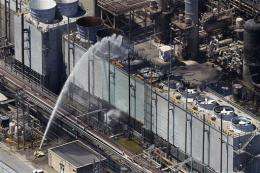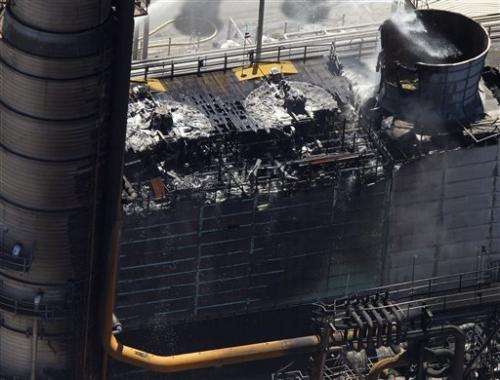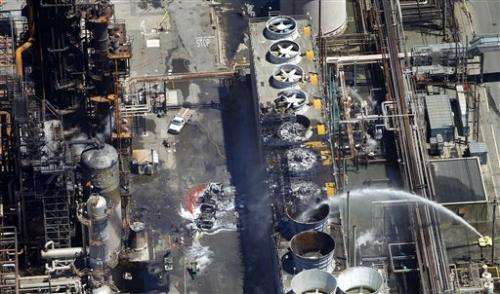Firefighting crews continue to pour water onto a unit after a fire at a Chevron refinery on Tuesday, Aug. 7, 2012 in Richmond, Calif. The fire, which sent plumes of black smoke over the San Francisco Bay area, erupted Monday evening in the massive Chevron refinery about 10 miles (16 kilometers) northeast of San Francisco. It was out early Tuesday. (AP Photo/The Contra Costa Times, Aric Crabb)
(AP) — A massive Chevron oil refinery fire that sent hundreds of people rushing to hospitals and is pushing West Coast gas prices higher was just the latest pollution incident at the facility that records show has increasingly violated air quality rules over the past five years.
The refinery is one of three such facilities near San Francisco that rank among California's top 10 emitters of toxic chemicals, according to the U.S. Environmental Protection Agency's Toxic Release Inventory.
Chevron's Richmond refinery — the scene of Monday's fire that shrouded the area in black smoke — has been cited by San Francisco Bay area regulators for violating air regulations 93 times in the past five years.
The number has increased from 15 violations in 2007 to 23 in both 2010 and 2011. The refinery is also the state's largest emitter of greenhouse gases, according to state regulators.
The Richmond refinery produces about 150,000 barrels of gasoline a day — or 16 percent of the West Coast's daily gasoline consumption of 963,000 barrels, said Tom Kloza, chief oil analyst at Oil Price Information Service.
Firefighting crews continue to pour water onto a unit after a fire at a Chevron refinery on Tuesday, Aug. 7, 2012 in Richmond, Calif. The fire, which sent plumes of black smoke over the San Francisco Bay area, erupted Monday evening in the massive Chevron refinery about 10 miles (16 kilometers) northeast of San Francisco. It was out early Tuesday. (AP Photo/The Contra Costa Times, Aric Crabb)
With inventories of gasoline in the region already low compared with the rest of America, pump prices on the West Coast will soon average more than $1 a liter, Kloza said.
Investigations continued Wednesday into Chevron's response to the fire and the effectiveness of Contra Costa County's emergency warning system. The U.S. Chemical Safety Board, a federal agency, sent a seven-member team to look into possible exposure of workers after vapor ignited and caused the fire.
Monday wasn't the first time Richmond residents had received shelter-in-place orders to stay in their homes and close the doors and windows after fires or accidents at nearby refineries.
They were anxious about the latest fire, and reports of a minor, secondary fire at the refinery on Wednesday only magnified concerns.
"Events like this most recent fire are a trigger for a longstanding mistrust of Chevron," said Jason Corburn, a University of California, Berkeley public health and urban planning professor. "People feel these spikes in air pollutants, and feel these dangerous events in the context of the daily (air quality issues) that don't show up on county air monitors."
The Richmond facility is not the biggest violator of air quality laws among the region's five oil refineries, but it has been cited for violating air regulations numerous times. Some of the violations remain under investigation for determination of penalties.
Firefighting crews continue to pour water onto a unit after a fire at a Chevron refinery on Tuesday, Aug. 7, 2012 in Richmond, Calif. The fire, which sent plumes of black smoke over the San Francisco Bay area, erupted Monday evening in the massive Chevron refinery about 10 miles (16 kilometers) northeast of San Francisco. It was out early Tuesday. (AP Photo/The Contra Costa Times, Aric Crabb)
Chevron spokeswoman Melissa Ritchie said in an email that the refinery "places the highest priority on the health and safety of our work force, our neighbors and the protection of the environment."
Some of the San Francisco Bay area's other refineries have more violations than Chevron. The most involved a Valero-owned refinery in nearby Benicia, which has 222 violations over the same five-year period. A Shell refinery in Martinez, a few miles (kilometers) east of the Chevron facility, posted the fewest violations with 83.
Not all of the air violations were for exceeding legal limits on pollution emissions, said Brian Bateman, the district's health and science officer. Some, he said, can be for bad record-keeping or other administrative problems, as well as equipment problems.
While the sprawling Chevron refinery has produced much of the West Coast's daily gasoline supply over the past dozen years, it has also emitted an average of 543,155 pounds (246,373 kilograms) of toxic chemicals into the air annually, according to EPA data.
In 2010, all of the state's toxic emitters, including hazardous waste disposal sites combined, released more than 9 million pounds of toxic chemicals into the air.
Chevron paid $170,000 to the air district for all of its violations between 2005 and 2009 after reaching a settlement. The total amount of fines for more recent violations has not been determined.
The federal Clean Air Act sets limits on pollutants that refineries and other emitters can release and imposes penalties for violations. Local air districts enforce the law.
While some of the region's 27 air monitoring station's detected an uptick in pollution during Monday's fire, further laboratory testing confirmed that the levels did not pose a significant health concern, the air district said.
Copyright 2012 The Associated Press. All rights reserved. This material may not be published, broadcast, rewritten or redistributed.


























